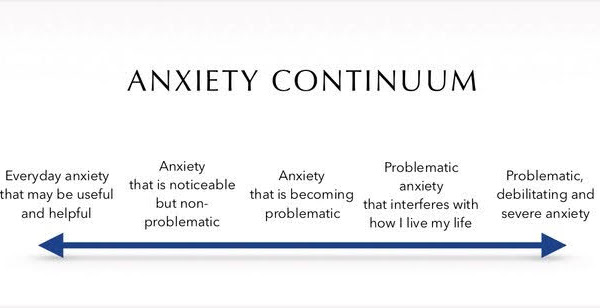Transforming Anxiety into Peace
Nothing can bring you peace but yourself. ~ Ralph Waldo Emerson
More Canadians are experiencing anxiety than ever before because of everyday life's challenges. It isn’t something you forget easily, especially when it happens on a regular basis.
Anxiety creeps into our awareness. Our hearts pound, sweat bursts onto our bodies and a sense of panic floods our minds. We worry that we'll never feel in control - ever again.
Despite these symptoms, it’s important to know that anxiety is manageable when we understand what it is, why it happens, how it works – and when we have the tools to transform it.
Anxiety is…
Let’s begin by defining what anxiety is and look at some of the typical symptoms that make us sit up and take notice of it.
The simplest way of defining it is this:
“Anxiety is a feeling of unease, such as worry or fear, that can be mild or severe.”
Anxiety impacts us physically, emotionally, behaviourally, and cognitively. Symptoms may be mild to severe and experienced differently from one person to the next. The intensity of each symptom is also unique to each person and can be influenced by the situation that we find ourselves in.
Symptoms:
- Physical:
- Shortness of breath
- Sweating
- Heart racing
- Shaking, muscle tension
- Chest pain (sometimes mistaken for a heart attack)
- Nausea or feeling sick
- Dizziness
- Butterflies in your tummy
- Chills or Hot flashes
- Trouble sleeping
- Emotional:
- Jumpiness
- Fear
- Unease
- Worry
- Panic
- Nervousness
- Behavioural:
- Avoiding situations, people, and things that trigger anxiety i.e. taking the bus instead of driving
- Escaping or running away from a situation, person, or thing that triggers anxiety
- Limiting daily activities to reduce anxiety
- Overly attaching to a person or thing as a way to feel safe
- Engaging in risky, destructive or unsafe behaviours (excessive drinking/drugging etc.)
- Cognitive – repeated thoughts that keep us feeling worried and anxious
- What if ______?
- Am I crazy?
- People will judge, criticize, laugh at me.
- What’s wrong with me?
- Why can’t I control this?
- I must be broken.
Other symptoms include difficulty concentrating, focusing, remembering, and staying present. We might also find ourselves thinking that things are hopeless, and we are helpless.
Nothing could be further from the truth!
The Anxiety Continuum

The anxiety continuum is a great tool to help us assess when to seek support and help.
We all feel anxious at some point in our lives - before we take an exam, or go live on Facebook for the first time, sending our children off to their first day of school, or presenting a proposal to a new client. Feeling nervous and anxious in these kinds of situations is normal.
When anxiety reaches the middle point on the continuum, where it becomes problematic, it is time to check-in with a counsellor or mental health professional. If left to thrive, anxiety eventually takes over and dominates every aspect of our lives. While it is estimated that severe anxiety impacts 1 in 10 Canadians, anxiety disorders are treatable and manageable.
All too often, we don’t let others know what’s happening to us. We believe we should be able to handle it ourselves, don’t want to bother anyone with our problems, or we feel embarrassed that we can’t “get it together”.
The reality is that if you’re feeling anxious, others are too!
The Anxiety Response
Anxiety begins with our thoughts and feelings. When we believe danger is near, our brain sends a message to our body to be on alert and prepare to fight or flee.
Our emotional brain, the Amygdala, is responsible for finding and alerting the rest of the brain to threats. For anyone experiencing anxiety regularly, the prefrontal cortex (our logical brain) struggles to calm the excitable Amygdala. This leaves our brain and body on high alert, ready to fight or flee whether the threat is real or imagined.
Growing up in an abusive, threatening, or challenging family environment puts your brain on high alert for danger - even when there isn’t any. And there is also evidence to suggest that there is a genetic component to anxiety disorders as they flow through families and are passed down from generation to generation.
So, how can we transform anxiety, so we feel in control, less stressed and peaceful?
5 Steps to Transforming Anxiety into Peace
Implementing these 5 steps, wherever you are on the anxiety continuum, will go a long way to helping you tame your runaway thoughts and find peace within when the anxiety gremlin comes knocking at your door.
Remember to be patient with yourself as you implement each one.
- Breathe: Anxiety creates a stress response in our bodies. Have you noticed that when you feel anxious, you hunch over to protect your heart and lungs? The way to feeling less stressed and more in control, is to:
• Sit or stand up straight
• Put your shoulders back
• Plant your feet firmly on the ground and
• Take a few deep breathes in and out.
This simple, yet powerful technique, interrupts the anxiety response and reminds us that we aren’t in danger.
- Movement: Anxiety would much prefer that you give in to it as it begins to creep into your mind and body. To outsmart it, put your runners on and go for a walk. Since your body is already on high alert and revved up, running may not be the best activity, but walking gets you breathing deeper and allows you to think and feel differently.
- Listen to Music: Music has the power to heal our troubled minds. Put on your headphones and listen to soothing, calming music. Choose music that takes your mind away from the chaos within your mind. Prepare ahead of time by making a playlist specially designed for when you feel anxious.
- Journal: Writing your thoughts and feelings down on paper gets them out of your head and on to paper. This is an excellent tool to help you interrupt anxiety’s hold on you. The act of writing is physical, mental and emotional – a perfect trio for letting go of those pesky thoughts that trigger your anxiety!
- Support: Learning to manage anxiety is an inside job and yet there are times when we need outside help and support. Reach out to family, friends, or a counsellor you can trust and let them know about your challenges with anxiety. And finally, you deserve to be patient, kind and compassionate with yourself as you learn that anxiety is just a signal to let you know there are things to pay attention to.
The Family Centre offers counselling that can help you deal with anxiety and the challenges of life.
There’s no need to suffer in silence when help is just a phone call away. Contact us to find out more about how you can transform anxiety into peace.
Additional Resources:
Post written by Joan Ridsdel
Joan Ridsdel is the founder and creator of W.I.S.E.R Woman Coaching and Personal Development. She is a Registered Social Worker & Food Freedom and Body Confidence Coach, specializing in helping women stop dieting so they can create a peaceful, free relationship with food and their bodies. Joan offers 1-1 and small group coaching sessions.
Contact Joan at:
Email Address: coach@joanridsdel.com
Website: www.joanridsdel.com
Facebook: https://www.facebook.com/joanridsdelcoaching

